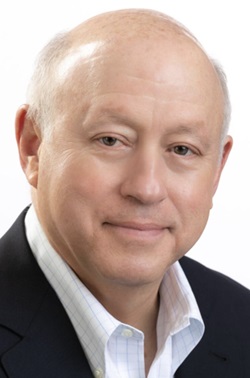08/30/2024
Strong Partnership Between Federation President, Board Chair ‘Sets Cleveland Apart’

BECKY RASPE | CJN
It is said a leader is only as strong as their support system. And for many organizations, the relationship between its president and CEO, and board chair is more than just a partnership – it is often a pivotal force that can be felt throughout all operations.

Hoffman
For the Jewish Federation of Cleveland, which is celebrating its 120th year of operations, that adage – and the power the president-board chair relationship holds in steering a community through good times and bad – can’t be overstated, according to president emeritus Stephen H. Hoffman. Hoffman spent 44 years with the Jewish Federation of Cleveland, including 35 years as president. In the role from 1983 to 2018, Hoffman was succeeded by Erika Rudin-Luria in 2019.
Hoffman interfaced with a dozen board chairs, including Henry J. Goodman (1982 to 1985); Milton A. Wolf (1985 to 1988); Max R. Friedman (1988 to 1991); Bennett Yanowitz (1991 to 1994); Sally H. Wertheim (1994 to 1997); Robert Goldberg (1997 to 2000); Charles A. Ratner (2000 to 2003); Timothy F. Wuliger (2003 to 2006); Harley I. Gross (2006 to 2010); Michael Siegal (2010 to 2013); Reneé Chelm (2013 to 2016); and Gary L. Gross (2016 to 2019). Since becoming chairman of the Jack, Joseph and Morton Mandel Foundation’s board of trustees, the Jewish Federation of Cleveland has seen two other board chairs – J. David Heller (2019 to 2022) and its current chair Daniel N. Zelman.
Each of those partnerships was paramount in his development as a Jewish communal leader, Hoffman told the Cleveland Jewish News.
“When I first started, I was pretty young, relatively speaking,” Hoffman, who lives in Shaker Heights and is a congregant of B’nai Jeshurun Congregation in Pepper Pike, said. “I was just turning 33. I knew enough for them to invite me to be their chief professional officer, but not at all what I knew at the end. I would say I was fortunate to have learned so much from each board chair and each of them enhanced my professional practice. I took something special from each of them, and they all came with very different experiences. And yet, even when I was at the end, I was still learning from my (last board chair) Gary Gross.”
That level of collaboration “says a lot” about the mutual respect that Federation professionals have for their volunteer leaders, Hoffman said, adding an organization like the Jewish Federation of Cleveland “belongs to the volunteers” as it develops policy on how to address community challenges, and sets budgets on how to spend organizational time and resources.
“In some communities, the chief professional officer sometimes loses touch with reality, and they think they’re the organization,” he said, with a laugh. “I never felt that way. I always understood that it is a partnership. There is a role you play to provide the management and historical experience, provide options on how to confront a particular challenge and shape the consensus that we strove to achieve on big decisions. There were times I could reach out and talk to different segments of the volunteer community, but, at the end of the day, I relied heavily on the relationships (the board chairs) had.”
Noting each chair had their careers, circles of influence, friend groups and networks, Hoffman said they were often “out in the community talking to people.”
And while it is not unique to Cleveland, Hoffman said many past board chairs remained involved in the Federation mission. Before his tenure, the Jewish Federation of Cleveland saw 17 other board chairs – Charles Eisenman (1903 to 1923); Edward M. Baker (1923 to 1927); Bertha Beitman Herzog (1927 to 1930); Sol Reinthal (1930 to 1933); Louis Bing (1933 to 1936); Joseph M. Berne (1936 to 1945); Henry A. Rocker (1945 to 1953); Max Freedman (1953 to 1956); Max Simon (1956 to 1959); L.W. Neumark (1959 to 1962); M.E. Glass (1962 to 1965); David E. Myers (1965 to 1968); Lloyd S. Schwenger (1968 to 1971); Maurice Saltzman (1971 to 1974); Morton L. Mandel (1974 to 1976); Albert B. Ratner (1976 to 1979); and Lawrence H. Williams (1979 to 1982).
“There aren’t too many examples where past board chairs remain actively engaged in the work of the Federation, not just as donors, but as thought leaders,” Hoffman said. “It’s not uncommon in Cleveland to gather past chairs with current chairs to talk issues through and get advice. We’ve been very fortunate in the way they never disappear, are always active, engaged and show up.”
Hoffman said he frequently traveled both nationally and internationally with his board chairs, sharing experiences, which “are special in their own right.” He added each chair had their own “historical challenges” so “you remember how you dealt with them together.” For example, when he served with Freedman, who was board chair from 1988 to 1991, Hoffman recalled many of the Jewish Federation of Cleveland’s campaigns were targeted toward Jews who were fleeing the former Soviet Union.
“We were running one campaign after another,” Hoffman said. “Max had been a past campaign chair and he was perfect for what we were going through at the time.”
In 2009, while Gross, a partner at Gross Residential, was near the end of his board chair tenure, the Jewish Federation of Cleveland secured a $16 million grant from Jack, Joseph and Morton Mandel to purchase and renovate a building in Beachwood to serve as its new headquarters. At the time, operations were in downtown Cleveland. The Jewish Federation of Cleveland remains in its Beachwood building, called the Jack, Joseph and Morton Mandel Building, at 25701 Science Park Drive to this day.
The coincidences that each board chair seemed to fit current needs – both seen and yet-to-be-seen – is an irony not lost on Hoffman, he said.
“There were always challenges, but I often felt that each chair serving at the time always was the exact right board chair that met the needs of the challenges we were facing,” he said. “I would always tease that there had to be some divine plan. ... Some had to react to war and rose to the occasion, and others had to deal with very serious communal challenges. They all came through beautifully.”
A professional community based on mutual respect, Hoffman said each board chair regarded the next with patience and understanding.
“None of them, and I mean none of them, actually knew what it is like before they become board chair,” he said. “... They all have great empathy for the current board chair and they’re willing to do whatever they can to help the current board chair in what he or she wants to accomplish. That is special. It’s often said that the success, or failure, of the (president) of a Federation has everything to do with their relationship with the board chair and the board in general. And that is true in Cleveland. We’ve had wonderful professionals in our 120-year history.”
Hoffman likened back to something he’d often hear from Mort Mandel, who served as chair from 1974 to 1976 – “great professionals attract great volunteer leaders,” adding that the reverse is “equally true.”
“It’s not one or the other,” he said. “And that’s what sets Cleveland apart. If I put humility aside, we’ve had great professionals. And I think that’s because we’ve had great board chairs. We want to work with them and they want to work with (us).”

